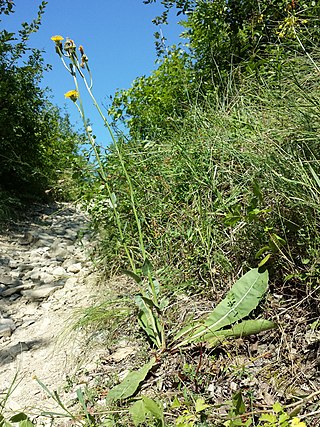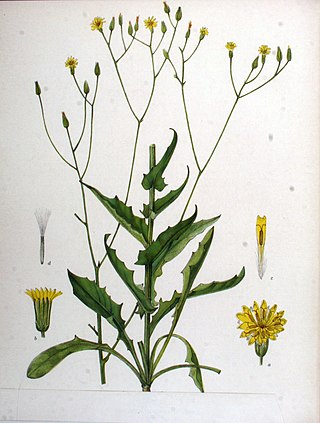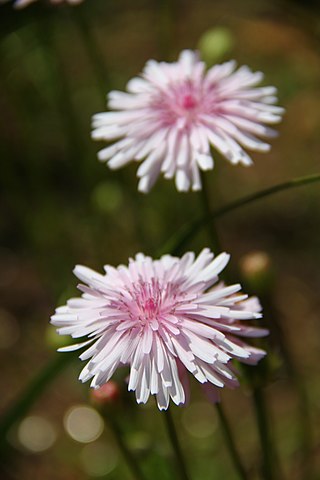
Crepis capillaris, the smooth hawksbeard, is a species of flowering plant in the tribe Cichorieae within the family Asteraceae, and is native to Europe. It has become naturalized in other lands and is regarded as a weed in some places.

Pyrrocoma is a genus of North American plants in the family Asteraceae. These wildflowers are sometimes known as goldenweeds.
Crepis monticola is a North American species of flowering plant in the family Asteraceae known by the common name mountain hawksbeard.

Calochortus elegans is a species of flowering plant in the lily family known by the common name elegant Mariposa lily, cat's ear, elegant cat's ears or star tulip. It is native to the western United States from northern California to Montana.

Crepis acuminata is a North American species of flowering plant in the family Asteraceae known by the common name tapertip hawksbeard. It is native to the western United States where it grows in many types of open habitat.
Crepis bakeri is a species of flowering plant in the family Asteraceae known by the common name Baker's hawksbeard. It is native to the western United States where it grows in many types of mountain and plateau habitat. It is found in Oregon, Washington, Idaho, northern California, Nevada, and Utah.

Crepis intermedia is a North American species of flowering plant in the family Asteraceae known by the common name limestone hawksbeard. It is native to the Pacific Northwest, Columbia Plateau, Great Plains and Southwestern regions of western North America.

Crepis modocensis is a species of flowering plant in the family Asteraceae known by the common name Modoc hawksbeard.

Crepis occidentalis is a North American species of flowering plant in the family Asteraceae known by the common names western hawksbeard, or largeflower hawksbeard. It is native to western Canada and the western United States.
Crepis pleurocarpa is a North American species of flowering plant in the family Asteraceae known by the common name nakedstem hawksbeard. It is native to the western United States (Washington, Oregon, northern California and western Nevada.

Crepis runcinata is a North American species of flowering plant in the family Asteraceae known by the common name fiddleleaf hawksbeard. It is native to western and central Canada, the western and central United States and northern Mexico (Chihuahua).

Crepis tectorum, commonly referred to as the narrowleaf hawksbeard or narrow-leaved hawk's-beard, is an annual or winter annual plant between 30 and 100 centimetres in height. Originating in Siberia before being introduced to Canada in 1890, the narrowleaf hawksbeard's is an invasive species. Maintaining one branched, hairless and leafy stem during maturity, the narrowleaf hawksbeard has yellow leaves which are arranged in an alternate manner and less than 0.5 inches (13 mm) wide.

Askellia pygmaea, the dwarf alpine hawksbeard, is a species of Asian and North American plants in the tribe Cichorieae within the family Asteraceae.
Crepis atribarba is a North American species of flowering plant in the family Asteraceae known by the common names slender hawksbeard and dark hawksbeard. It is native to western Canada and the western United States It has been found in British Columbia, Utah, Washington, Oregon, Nevada, Idaho, Alberta, Montana, Wyoming, Colorado, Saskatchewan, and Nebraska.

Crepis nicaeensis is a European species of flowering plant in the family Asteraceae with the common names French hawk's-beard and Turkish hawksbeard. It is widespread across much of Europe, as well as being sparingly naturalized in scattered locations in the United States and Canada.

Crepis pannonica, the pasture hawksbeard, is a European species of flowering plant in the family Asteraceae. It is native to eastern Europe and the Caucasus, as well as being sparingly naturalized in the State of Connecticut in the northeastern United States.

Crepis pulchra is a European species of flowering plant in the family Asteraceae with the common name smallflower hawksbeard. It is widespread across much of Europe as well as in Morocco, Algeria, and western and central Asia. It has also become naturalized in the parts of the United States and in the Canadian Province of Ontario.

Crepis rubra is a European species of flowering plant in the family Asteraceae with the common name red hawksbeard or pink hawk's-beard. It is native to the eastern Mediterranean region and is widely cultivated as an ornamental. It became naturalized in a small region of the United States.

Crepis setosa, the bristly hawksbeard, is a European species of flowering plant in the family Asteraceae. It has become naturalized in North America and occurs Washington, Oregon, California, Idaho, Montana, Texas, Arkansas, Missouri, Tennessee, Wisconsin, Ohio, Pennsylvania, New York, Connecticut and Vermont.

Crepis vesicaria is a European species of flowering plant in the family Asteraceae with the common name beaked hawk's-beard. It is native to the Western and Southern Europe from Ireland and Portugal east as far as Germany, Austria, and Greece. It became naturalized in scattered locations in North America.
















